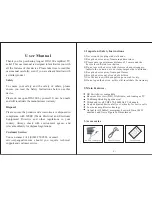
Page-27
BevFlex-4X Installation Manual Rev 2.23 November 2019
Quad shield is ideal, but not necessary. The better the shielding, the less likely you will pick up unwanted
interference. We recommend using a good quality cable with a UV resistant jacket and weatherproof connectors.
Any good quality 75 Ohm characteristic impedance coaxial cable can be used, including coaxial cables that
incorporate a supporting, steel messenger/carrier wire.
If long spans are required between supporting posts or trees, the use of coax with a supporting messenger/carrier
wire is desirable. Much of the surplus coaxial cable from CATV companies has an integrated messenger wire and
can often be obtained for free. If the cable has a supporting messenger wire, this wire needs to be insulated from
the end supports and all intermediate supporting structures. Normally the messenger wire can be left floating from
the RG-6 shield, but can be optionally connected to the shield of the F connectors on the end termination units with a
3/8” ID lug and nut.
Flooded, self-sealing RG-6 is an advantage for BOG configurations and buried feed lines back to the shelf. Small
animals may chew through the outer jacket. Flooded RG-6 will seal the openings, preventing water from getting into
the coax.
14.
What effect does my local ground conductivity have on antenna performance, and should I make any
adjustments to the height above ground to compensate for this?
When mounted at least 7 ft. above ground level, electromagnetic modeling of the BevFlex-4X antenna shows little
effect on the an
tenna’s performance over a range of soil conductivities between 0.1 mS/m and 50 mS/m, which are
typically found in most locations.
15.
How will weather conditions affect the performance of my antenna?
No more so than with any other wire antenna installation. The reversible Beverage allows you to switch directions to
reduce interference from atmospheric storms coming from predominantly one direction. In such cases, it is better
than other antennas for receiving under high noise conditions.
16.
Why are there ground connections on each of the end terminating units?
The ground rods provide a connection between the custom reflection transformers at each end of the antenna and
the ground under the antenna, which completes the circuit between the two ends of the antenna.
17.
Will I need to use an external preamp with this antenna?
Generally, no external pre-amplifier is required or desired as signal levels from the BevFlex-4X are well above the
noise floor of your receiver on frequencies below 10 MHz. Received signals from the BevFlex-4X will almost always
be LOWER in “S” meter readings than on your transmit antenna, but the overall signal to noise ratio will be higher.
An antenna pre-amplifier may be helpful for a BevFlex-4X configured as a Beverage-On-Ground (BOG) or EWE at
frequencies above 7.0 MHz.
18.
What kind of connector is required to interface with my radio?
The output from the switching and termination unit is via a standard “F” connector matched to the 50 Ohm input
impedance found on most receivers. You will need to provide a 50 Ohm cable and the adapters required to connect
to your particular radio. (“F” to BNC, PL-259, RCA phono, etc.)
19.
Do I need to use 50 ohm cable between the switching unit and my radio?
With the short lengths of cable involved in most installations, either 50 Ohm or 75 Ohm coaxial cable can be used.





































